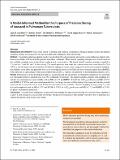A model-informed method for the purpose of precision dosing of isoniazid in pulmonary tuberculosis
Abstract
Background and ObjectiveThis study aimed to develop and evaluate a population pharmacokinetic model and limited sampling strategy for isoniazid to be used in model-based therapeutic drug monitoring. MethodsA population pharmacokinetic model was developed based on isoniazid and acetyl-isoniazid pharmacokinetic data from seven studies with in total 466 patients from three continents. Three limited sampling strategies were tested based on the available sampling times in the dataset and practical considerations. The tested limited sampling strategies sampled at 2, 4, and 6 h, 2 and 4 h, and 2 h after dosing. The model-predicted area under the concentration–time curve from 0 to 24 h (AUC24) and the peak concentration from the limited sampling strategies were compared to predictions using the full pharmacokinetic curve. Bias and precision were assessed using the mean error (ME) and the root mean square error (RMSE), both expressed as a percentage of the mean model-predicted AUC24 or peak concentration on the full pharmacokinetic curve. ResultsPerformance of the developed model was acceptable and the uncertainty in parameter estimations was generally low (the highest relative standard error was 39% coefficient of variation). The limited sampling strategy with sampling at 2 and 4 h was determined as most suitable with an ME of 1.1% and RMSE of 23.4% for AUC24 prediction, and ME of 2.7% and RMSE of 23.8% for peak concentration prediction. For the performance of this strategy, it is important that data on both isoniazid and acetyl-isoniazid are used. If only data on isoniazid are available, a limited sampling strategy using 2, 4, and 6 h can be employed with an ME of 1.7% and RMSE of 20.9% for AUC24 prediction, and ME of 1.2% and RMSE of 23.8% for peak concentration prediction. ConclusionsA model-based therapeutic drug monitoring strategy for personalized dosing of isoniazid using sampling at 2 and 4 h after dosing was successfully developed. Prospective evaluation of this strategy will show how it performs in a clinical therapeutic drug monitoring setting.
Citation
van Beek , S W , ter Heine , R , Alffenaar , J W C , Magis-Escurra , C , Aarnoutse , R E , Svensson , E M , the Isoniazid Precision Dosing Group & Gillespie , S 2021 , ' A model-informed method for the purpose of precision dosing of isoniazid in pulmonary tuberculosis ' , Clinical Pharmacokinetics , vol. First Online . https://doi.org/10.1007/s40262-020-00971-2
Publication
Clinical Pharmacokinetics
Status
Peer reviewed
ISSN
0312-5963Type
Journal article
Description
No funding was received specifically for this study or for the preparation of this article. Elin M. Svensson is supported by PanACEA, which is part of the European and Developing Countries Clinical Trials Partnership (EDCTP) 2 programme supported by the European Union (Grant number TRIA2015-1102-PanACEA).Collections
Items in the St Andrews Research Repository are protected by copyright, with all rights reserved, unless otherwise indicated.

